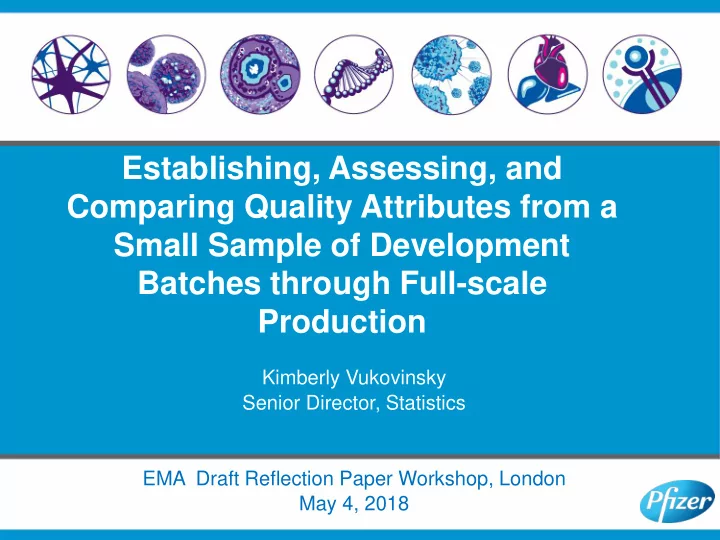

Establishing, Assessing, and Comparing Quality Attributes from a Small Sample of Development Batches through Full-scale Production Kimberly Vukovinsky Senior Director, Statistics EMA Draft Reflection Paper Workshop, London May 4, 2018
International Society of Pharmaceutical Engineering (ISPE) Comment • The three areas of application discussed in the reflection paper are entirely different situations for patients and for manufacturers. – e.g. The goal of a biosimilar comparison is different than a small molecule site transfer. • The analysis approach might be very different in each of these situations and the issues raised in the paper may be more or less important in each case. • ISPE recommends that the reflection paper be split into several documents. The scope of the current reflection paper is quite large and difficult to thoroughly cover. 2
Outline • Focus on Comparability during Pre-/Post- Manufacturing Change • Will describe a practical approach discussed within several member companies to establish, compare, and control quality attributes • Using Content Uniformity as an Example 3
Manufacturing Pre-/Post- Change Comparability Topics • Comparison Objectives : (Section 4.1) Goal is to show two processes “highly similar” safety and efficacy • Target Product Profile (TPP) • Quality TPP (QTPP) • Translation to Statistical Objectives : (Section 5.1.2) Non- inferior quality; (Section 7) deciding upon one- or two-sided comparison • Predefine Acceptance Region : (Section 5.6) arbitrariness of acceptance ranges might be unavoidable (Section 4.1) past … statistical intervals … the context rarely clear in relation to conclusions drawn 4
Establish, Compare, and Control Quality Attributes ICH Unit Dose Uniformity (UDU) Test Table 1. ICH UDU Content Uniformity Test All measurements of dosage units and criteria values are in percentage label claim (%LC). At each stage calculate the sample average and the sample standard deviation s . X Stage Number tested Pass stage if: |M - X| + 2.4s 15.0, where M is defined below. S 1 10 i) |M - X| + 2.0s 15.0 using all 30 results (S 1 + S 2 ) S 2 20 ii) No dosage unit is outside the maximum allowed range of 0.75*M to 1.25*M. M is defined as follows: If T is less than or equal to 101.5%LC, and is less than 98.5%LC, then M = 98.5%LC. (i) If 𝑌 is between 98.5 and 101.5%LC, then M = 𝑌 . (ii) If 𝑌 is greater than 101.5%LC, then M = 101.5%LC. (iii) If 𝑌 If T is greater than 101.5%LC, and is less than 98.5%LC, then M = 98.5%LC. If 𝑌 (i) is between 98.5 and T, then M = 𝑌 . (ii) If 𝑌 is greater than T, then M = T. (iii) If 𝑌 T is the Target content per dosage unit at the time of manufacture, expressed as percentage label claim. Unless otherwise specified in the individual monograph, T is 100.0%LC. 5
Setting Acceptance Range – What is Manufacturing Goal? Start with the end in mind: • The probability to pass ICH Probability to Pass ICH UDU UDU can be calculated from the test rules. – Goal based on Process Capability; appears arbitrary – Very well inside safety and efficacy considerations • A region of indifference (sufficient similarity) can be selected where operation anywhere in the space is acceptable. 6
Pre-change Assessment – What is Development Goal? Quality by Design; Develop a process (average performance) • Stratified Sampling of Content Uniformity data preferred (Section 5.3) • Transfer from development to manufacturing usually includes a small number of lots pre- and post- change (Section 4.1) Ability of Process to Achieve Development Goal 7
Post-Change Comparison: What is Transfer Goal? • Visual Comparison Using Pre-defined Limit • Is Product Performance at Scale Comparable to Development? • Is Post-Change highly similar with respect to safety and efficacy? • Investigate • Work to Understand Variability x x x • x Difference is x Acceptably Close x and Within x x x Comparison x x x Criteria • Sufficiently Similar 8
Elements in Manufacturing Comparability • Meaningful specification numerical limits – Types: Compendial (e.g. potency, content uniformity), Safety-based (e.g. tox study), Data-driven – Would like to realize a highly capable process, e.g. Ppk of 1.33 (4 sigma) or Ppk of 1.67 (5 sigma) – At times, data-driven based on a small set of data, e.g. min/max (~2 sigma) or 3 sigma (Ppk of 1.0) even in light of relevant knowledge • Sample Size – Tends to be small, even when much knowledge available – Reliable estimation of Standard Deviation • Distributional Considerations (Normality) / Science and engineering of the product and the control strategy • Risk prioritized • Criteria can vary attribute to attribute and product to product 9
Conclusion • Comparability is Integral to Design, Develop, and Transfer a Reliable, Consistent, Capable Process, and Manufacture a Safe, Efficacious, High Quality Product • Required: – Properly Engineered Formulation and Dosage Form – Meaningful specifications – Well Designed and Controlled Processes and Methods • For Manufacturing Transfer Recommend: – Understanding of data in context of science and engineering – Risk based prioritization to attribute selection – Statistical methods/criteria vary attribute to attribute – Statistical approach can include comparison against a goal – Always plot data; visual comparison 10
Recommend
More recommend